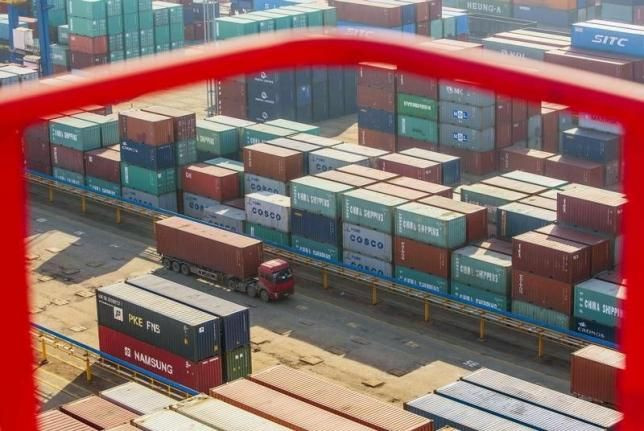China’s Exports Down 6.1% In August, Imports Fall 14.3%, But Trade Surplus Sharply Up

SHANGHAI -- China’s exports declined by 6.1 percent over the previous year -- in yuan terms -- in August, according to figures from the country’s Customs Administration.
The fall, slightly smaller than some analysts predicted, was less than July’s sharp drop of 8.9 percent, which took markets by surprise, sending tremors through the global economy, particularly after China devalued its currency soon afterwards. Nevertheless, observers said the latest figures are a reminder that China’s economy continues to face challenges in rebalancing to cope with slowing export demand.
China’s imports fell more sharply, by 14.3 percent in yuan terms, compared to 8.1 percent in July, with falling commodity prices seen as one factor.
The fall in imports left the country’s overall foreign trade for the month down 9.7 percent from a year earlier, but also meant that China’s trade surplus for the month was markedly up, by 20.1 percent year-on-year, to 368 billion yuan, or about $58 billion, compared to the average of about $43 billion for the first seven months of the year.
In dollar terms the fall in exports was 5.5 percent, compared to 8.3 percent in July -- below market expectations of a 6 percent drop, according to Reuters, or a 6.6 percent drop, according to Bloomberg.
Falls in exports to the European Union and Japan shrunk markedly in August, to 7.5 percent and 5.9 percent respectively, from 12.3 percent and 13 percent in July. August exports to the United States, meanwhile, were down 1 percent year-on-year, compared to 1.4 percent the previous month.

Li-gang Liu, chief China analyst at ANZ Banking Group, said in a note sent to International Business Times that exports to China’s Southeast Asian neighbors -- countries in the ASEAN bloc -- were down 4.6 percent last month, having risen 1.4 percent in July. And he said that despite the slightly smaller fall in exports, the figures were a reminder that the effective 2.8 percent devaluation of the yuan last month was unlikely to have a "significant impact" on China’s export competitiveness in the near term.
At the same time, however, Liu said the significant trade surplus for August “should remind investors that China does not suffer large net capital outflows.” While China’s foreign reserves declined by $93 billion in August, to $3.557 trillion -- after the government intervened in the foreign exchange market to stabilize the yuan following its devaluation of 2.8 percent -- Liu suggested the latest figures showed that China’s central bank would still be able to intervene to keep the currency within a range “it would like to see.”
Chinese state media said recently that China's exports for the year could be up around 2 percent, with imports down some 10 percent. However, with exports in yuan terms currently down 1.6 percent for the January-to-August period, and imports down 14.6 percent, analysts are agreed that further measures need to be taken.
Liu Xuezhi, an analyst at China’s Bank of Communications, told Bloomberg that with export prospects weak, the authorities would need to do more to stabilize growth, with infrastructure spending being key.
China’s Finance Minister Lou Jiwei promised at the weekend that the government would increase spending for the year by 10 percent, rather than 7 percent as planned.
China’s top economic planning body, the National Development and Reform Commission, was reported on Tuesday to have approved six new infrastructure projects worth about $12 billion, mainly for the construction of highways in the west of the country, Shanghai-based China Business News reported.
The Chinese government also announced a draft plan to introduce a "circuit-breaking" mechanism aimed at preventing excessive volatility on the country’s markets -- by suspending trading for 30 minutes if leading shares rise or fall by 5 percent in a day, and closing the market for the day if it opens up or down 7 percent.
Some Chinese analysts questioned how effective the measures would be, however, according to respected financial website Caixin -- and China’s markets were down in morning trading. But they rebounded sharply in late trading, as the government injected more liquidity into the market. The main Shanghai Composite Index closed 2.9 percent up, while the secondary Shenzhen Composite Index finished 3.8 percent higher. The volatile ChiNext Index for high-tech shares was up 5.6 percent.
Hong Kong’s Hang Seng Index closed up 3.28 percent, while Singapore's Straits Times Index was up 1.2 percent. In Sydney the ASX 200 gained 1.7 percent.
In Japan, however, concerns about China’s economy sent the Nikkei tumbling to its lowest point of the year – it fell 2.4 percent to close at 17,427. South Korea's Kospi finished 0.2 percent lower.
© Copyright IBTimes 2024. All rights reserved.





















